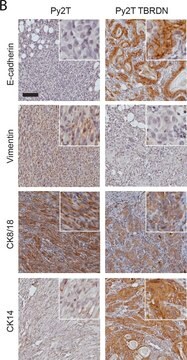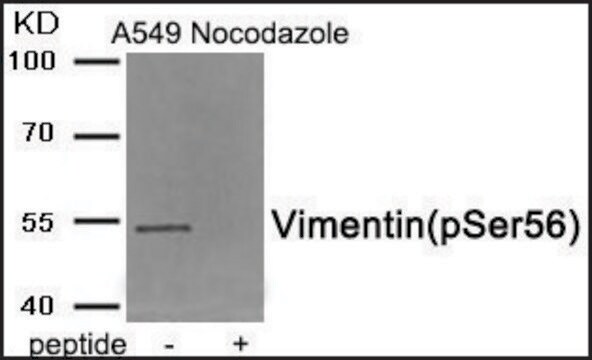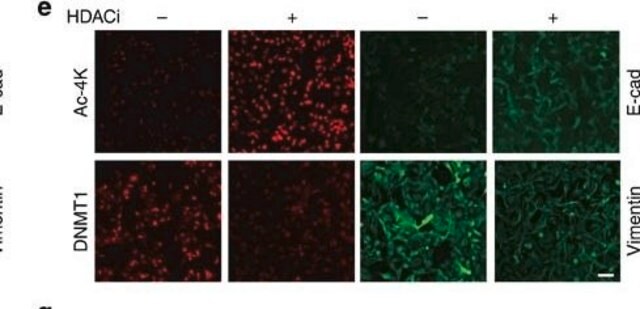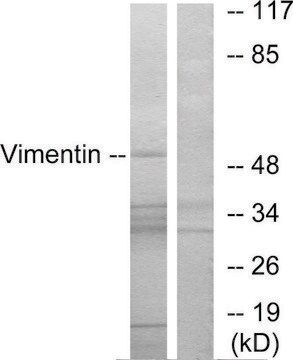一般說明
Anti-Vimentin antibody, Mouse monoclonal (mouse IgM isotype) is derived from the LN-6 hybridoma produced by the fusion of mouse myeloma cells and splenocytes from mouse. Vimentin protein is localized in a wide range of cell types, including pancreatic precursor cells, sertoli cells, mesangial cells, trophoblastic giant cells, neuronal precursor cells, fibroblasts, macrophages, endothelial cells of lung blood vessels, renal tubular cells, neutrophils, leukocytes and renal stromal cells.
Vimentin is a specific type III intermediate filament (IF) protein. It is abundantly expressed in mesenchymal cells. The gene encoding vimentin is located on human chromosome 10p13.
特異性
Anti-Vimentin antibody, Mouse monoclonal specifically recognizes a unique epitope of Vimentin protein which is not expressed in cells of hematopoetic derivation. The antibody is reactive with benign and malignant tumors of mesenchymal and neural derivation but does not react with normal and malignanat human lymphoid cells or derived malignancies. The antibody reacts with Vimentin from human, hamster, mouse, rat, canine, monkey, bovine, porcine and rabbit origin.
免疫原
Human thymic nuclear extract
應用
Anti-Vimentin antibody, Mouse monoclonal may be used in:
- immunoblotting
- immunofluorescence
- flow cytometry
- immunoprecipitation
- immunohistochemistry
生化/生理作用
Vimentin helps to preserve the structure of cells and stability of tissue in mesenchymal cells. It is involved in tumorigenesis, EMT (epithelial mesenchymal transition) and the metastatic of cancer. It also controls infectious internalization of human papillomavirus 16 pseudovirions.
Vimentin protein plays a significant role in supporting and anchoring the cellular position of organelles such as the nucleus, endoplasmic reticulum, mitochondria, maintenance of cell shape, the endurance of mechanical stress of mesenchymal cells and motility. Overexpression of the vimentin gene is observed in various epithelial cancers, including prostate, gastrointestinal tumors, central nervous system (CNS) tumors, breast, malignant melanoma and lung cancer.
外觀
Solution in 0.01 M phosphate buffered saline, pH 7.4, containing 15 mM sodium azide
儲存和穩定性
For continuous use, store at 2–8 °C for up to one month. For extended storage, freeze in working aliquots. Repeated freezing and thawing is not recommended. If slight turbidity occurs upon prolonged storage, clarify the solution by centrifugation before use. Working dilution samples should be discarded if not used within 12 hours.
免責聲明
Unless otherwise stated in our catalog, our products are intended for research use only and are not to be used for any other purpose, which includes but is not limited to, unauthorized commercial uses, in vitro diagnostic uses, ex vivo or in vivo therapeutic uses or any type of consumption or application to humans or animals.










